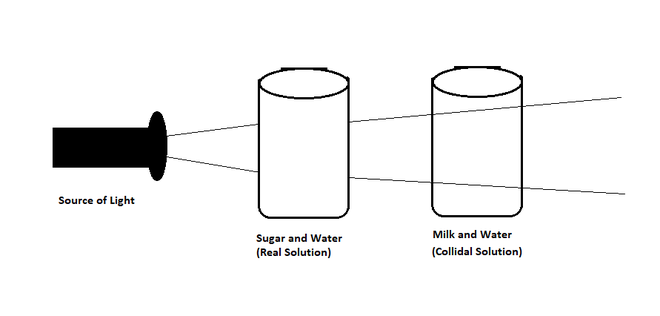光散射和廷德尔效应
廷德尔效应,也称为廷德尔现象,是光束被含有微小悬浮颗粒(例如房间中的烟雾或灰尘)的介质散射,使进入窗户的光束可见。短波长蓝光比长波长红光更强烈地分散,类似于瑞利散射。我们先来了解一下散射的概念。
光的散射
Scattering is the mechanism through which light is transmitted in all directions when it strikes a particle with a larger diameter.
可以完全探索光源。当光从一种介质移动到另一种介质(例如空气或一杯水)时,一部分光会被介质的粒子吸收,随后会沿特定方向辐射。光的散射是这种现象的术语。散射光的强度由颗粒大小和波长决定。
由于线的波纹及其与粒子的相互作用,较短的波长和高频散射更多。一条线越波浪,它就越有可能与粒子相交。另一方面,较长的波长具有较低的频率,更直,并且与粒子碰撞的可能性较低,因此机会较低。
瑞利散射定律
它指出,对于较短的波长,散射的概率会很高,并且它与辐射波长的四次方成反比。
设 p 为色散光量,λ 为波长
p ∝ 1λ4
因此,光散射随着波长的增加而减少。当某些粒子更有效地散射特定波长的光时,这称为瑞利散射。由于空气分子(例如氧气和氮气)很小,因此它们在散射较短波长的光(蓝色和紫色)方面更有效。
廷德尔效应
烟雾、水滴、灰尘和其他微小颗粒构成了地球的大气层。当光线遇到这些小粒子时,光线所经过的路径变得明显。这些粒子不断反射光,然后到达我们。廷德尔效应是粒子对光的散射现象。散射粒子的大小决定了散射光的颜色。
Tyndall effect refers to the scattering of light by particles in its path. When sunlight penetrates through the canopy of a thick forest, the Tyndall effect is also visible.
廷德尔发现,当七种颜色的白光通过含有微小悬浮颗粒的透明液体时,波长较短的白光的蓝色比较长波长的红色分散得多。
因此,当光束在黑暗环境中透过胶体溶液时,当通过垂直于光的方向放置的显微镜观察时,光线的路径就会被照亮。廷德尔效应是这种现象的名称。
廷德尔效应的原因
- 胶体颗粒比实际溶液中的溶质颗粒大。
- 胶体粒子从入射光中吸收能量,然后将其中的一部分从其表面分散出去。
- 因此,廷德尔效应是由胶体粒子的光散射引起的,胶体粒子可以看作是在黑色背景下移动的光点。
廷德尔效应的例子
- 在有雾的气氛中打开手电筒时,光的路径变得明显。这种情况下的光散射是由雾中的水滴引起的。
- 从侧面看,乳白色玻璃外观呈蓝色。然而,当光线透过玻璃照射时,会出现橙色的光。
- 当一束光线进入黑暗的房间时,我们能够看到灰尘颗粒。
- 牛奶是一种含有脂肪和蛋白质小球的胶体。当一束光射向一杯牛奶时,光会发生散射。这是廷德尔效应的一个很好的例子。
- 廷德尔效应是胶体或极微溶液中的粒子发生光散射的现象。

基于廷德尔效应的一些日常现象
- 天空的蓝色:天空的蓝色是由于大气中的空气分子分散了白色阳光中的蓝色成分而引起的。阳光由七种不同颜色的光混合而成。大气中的空气分子和其他微小颗粒的大小小于可见光的波长。这些在蓝色端的较短波长的光比在红色端的较长波长的光更有效地散射。红光的波长约为蓝光的 1.8 倍。结果,当阳光穿过大气层时,空气中的微小颗粒散射蓝色(较短波长)比红色(较长波长)更强。我们的眼睛充满了分散的蓝光。因为深空没有大气层可以散射阳光,所以天空显得暗黑而不是蓝色。在那些高度,散射是最小的。
- 日落和日出期间太阳的红色外观:在到达我们的眼睛之前,来自地平线附近的太阳的光会穿过更深的空气层和更远的地球大气层。来自头顶太阳的光的距离更短。结果,在中午左右,太阳看起来是白色的,因为只有少量的蓝色和紫色光被分散。大气中的空气分子和其他微小颗粒的大小小于可见光的波长。这些在蓝色端的较短波长的光比在红色端的较长波长的光更有效地散射。当太阳在日出和日落时接近地平线时,它必须穿过大气层的最大距离才能到达我们。阳光中包含的大部分较短波长的蓝色和较短波长在其漫长的航行中被分散了。结果,到达我们的光具有更长的波长。结果,太阳呈现深红色。
- 我们眼睛的蓝色:蓝色、棕色和黑色虹膜之间的主要区别在于其中一层的黑色素含量。与黑色虹膜相比,蓝色虹膜中的黑色素含量相对较低,因此是半透明的。当光入射到这个半透明层上时,由于廷德尔效应,它会被散射。因为蓝光的波长比红光短,所以更容易分散。未受损伤的光被更深层的虹膜吸收。因为大部分分散的光是蓝色的,所以这些虹膜具有独特的蓝色。
示例问题
问题1:什么是廷德尔效应?
解决方案:
Smoke, water droplets, dust, and other minute particles make up the earth’s atmosphere. The path travelled by a ray of light when it encounters these small particles becomes apparent. These particles continuously reflect light, which then reaches us. The phenomenon of light scattering by particles is known as the Tyndall effect.
问题 2:为什么天空呈现出清澈的蓝色?
解决方案:
天空呈现蓝色是因为当白光流过大气层时,紫罗兰色、靛蓝和蓝色会与悬浮粒子相互作用。这些波被吸收,然后扩散,我们的眼睛会接收到它们。
问题3:为什么日出和日落的颜色看起来是红色的?
解决方案:
The color of the sun and its surroundings appear crimson at sunset and sunrise. Because the sun is near the horizon at sunset and sunrise, the sunlight must travel a greater distance through the atmosphere. As a result, the particles scatter the majority of the blue light (shorter wavelength). Longer wavelength light (red color) penetrates human eyes. This is why the sun appears to be red.
问题4:为什么用红色来做危险信号或标志?
解决方案:
Because red has the longest wavelength, it scatters the most when it hits minuscule particles of fog and smoke (visible spectrum). As a result, we can see the red color vividly even from a great distance.
问题5:为什么太阳看起来是黄色的?
解决方案:
The sun appears yellow because violet, indigo, and blue colors are distributed across the upper atmosphere, resulting in yellow light. This light appears yellow as it enters our eyes.
问题 7:为什么对宇航员来说天空看起来很暗而不是蓝色?
解决方案:
An astronaut sees the sky as dark rather than blue: There are no particles in space, hence there is no scattering. As a result, the sky appears to be gloomy.
问题7:为什么在雾天从燃煤烟囱冒出的烟呈蓝色?
解决方案:
On a misty day, the smoke from a coal-fired chimney appears blue because the microscopic particles of smoke and moisture scatter blue light traveling through it. The smoke appears blue when this blue light reaches human eyes, and the sky appears dark instead of blue to an astronaut. There are no particles in space, hence there is no scattering. As a result, the sky appears to be gloomy.
问题8:为什么司机在雾天使用橙色灯而不是普通的白灯?
解决方案:
When a driver drives in fog while using white light, the tiny droplets of water scatter a lot of blue light. When this diffused blue light reaches the eyes, it reduces visibility, making driving extremely difficult. Orange light, on the other hand, does not scatter due to its longer wavelength, allowing the driver to see clearly.
问题 9:廷德尔效应如何影响蓝眼睛的颜色?
解决方案:
The quantity of melanin in one of the layers of the iris is the primary distinction between blue, brown, and black irises. When opposed to a black iris, the layer of a blue iris contains a smaller quantity of melanin, making it translucent. The Tyndall effect scatters light when it is incident on this translucent layer. When opposed to red light, blue light has a shorter wavelength and is hence scattered more. Unscattered light is absorbed by a layer deeper in the iris. Because the majority of the scattered light is blue, these irises take on a distinctive blue hue.